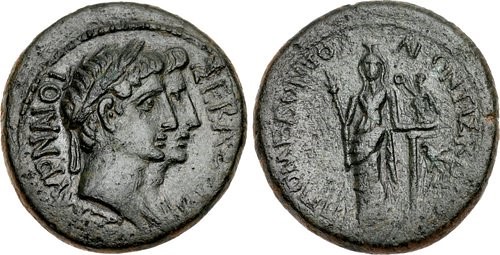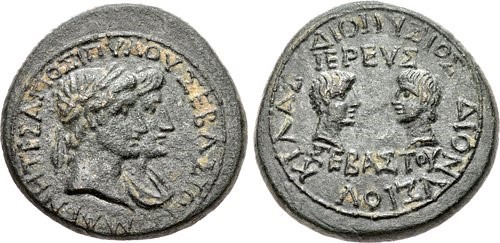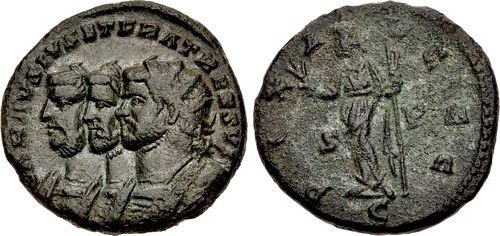
PREV ARTICLE
NEXT ARTICLE
FULL ISSUE
PREV FULL ISSUE
V25 2022 INDEX E-SYLUM ARCHIVE VOCABULARY TERM: JUGATEHere's another entry from Dick Johnson's Encyclopedia of Coin and Medal Terminology. -Editor Jugate. Two or more portraits joined side-by-side and overlapping to form the device appearing on one side of a numismatic item. The portraits face the same direction and the term is similar to accolated and conjoined, opposite of vis-a-vis (where the heads are facing each other). The term for one or more heads on both sides of a numismatic item is bijugate. See also portraits and portraiture.
Reference:
An NGC Ancients article nicely describes the topic - here are a couple examples. Note the term "confronted" for two portraits facing one another. -Editor We'll start with the jugate-style portraits on a 19mm bronze coin (above) struck in about 10 B.C. at the provincial mint of Smyrna. Produced well after Rome's first emperor, Augustus (27 B.C.-A.D. 14), had consolidated his authority in the Roman world, it shows the portraits of Augustus and his wife, the empress Livia. Taking the dual-portrait concept a step further, this 21mm bronze from the provincial mint of Magnesia in Lydia shows four members of Rome's first royal family. The obverse presents two portraits jugate (Augustus and Livia) and the reverse shows two confronted (Augustus' grandsons and heirs, Caius and Lucius). Why stop at two portraits? Is there a word for a coin image with three portraits? -Editor We'll end this brief survey with another rare and remarkable coin depicting three emperors. This billon double-denarius was produced in Britain, perhaps in A.D. 292, by the rebel-emperor Carausius (A.D. 286/7-293). He took the bold and presumptuous step of portraying himself with his two sworn enemies, the official Roman emperors Diocletian and Maximian. The coin is inscribed CARAVSIVS ET FRATRES SVI (‘Carausius and his brothers'), seemingly in the hope it might help spawn friendly relations or would deceive his subjects into believing such relations actually existed.
To read the complete NGC article, see:
To read the complete entry on the Newman Numismatic Portal, see:
Wayne Homren, Editor The Numismatic Bibliomania Society is a non-profit organization promoting numismatic literature. See our web site at coinbooks.org. To submit items for publication in The E-Sylum, write to the Editor at this address: whomren@gmail.com To subscribe go to: https://my.binhost.com/lists/listinfo/esylum All Rights Reserved. NBS Home Page Contact the NBS webmaster 
|



